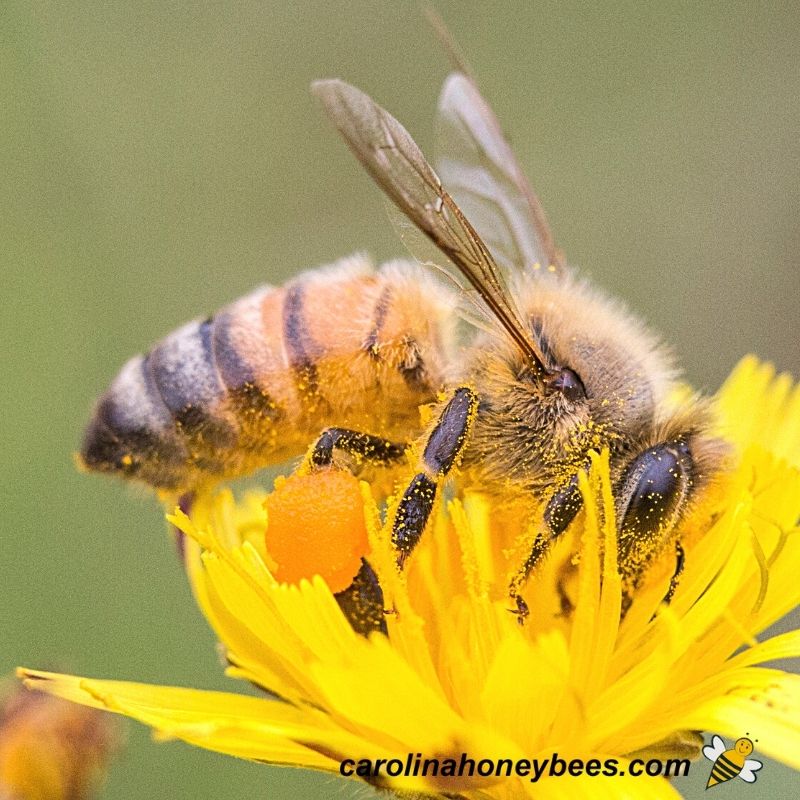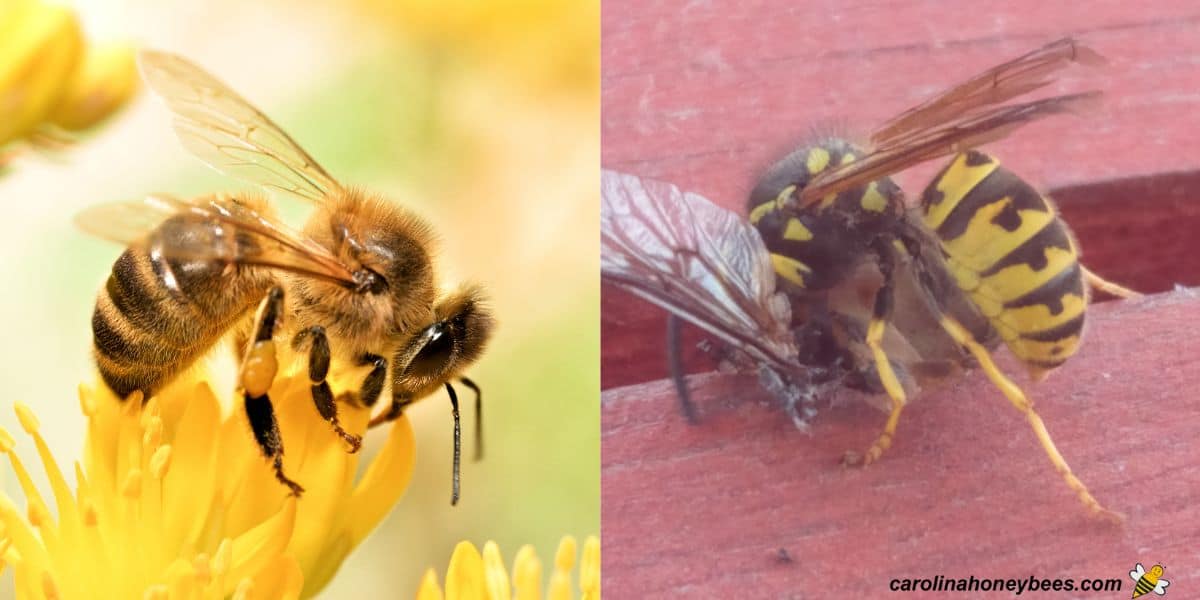Honey Bee vs Yellow Jacket
In a diverse insect world, these two cause a lot of confusion for folks who are not “bee savvy” –honey bee vs yellow jacket. They share some common insect characteristics but are very different. In fact, one actually preys on the other. However, once you understand their differences you are better equipped to share the world with them.

Taxonomy (a method of scientific classification) shows how one thing is related to another. Both honey bees and yellow jackets are insect members of the order “Hymenoptera”.
Yet, their differences begin to distinguish one from the other as we go farther along the family tree. In fact, yellow jackets are honey bee predators.
Key Differences Between Honey Bees and Yellow Jackets
When exploring the differences between honey bees and yellow jackets, let’s begin by understanding that (in fact) a yellow jacket is not a bee. It is a member of the wasp family.
This distinction may be of little importance to you-if you are being chased by flying stinging insects. But, it makes it much easier to understand why honey bees and yellow jackets are so different in many aspects of their lifestyles.
- appearance
- social structure
- feeding habits
- nesting habits
- aggression
- economic benefits
Appearance
If angry insects are telling you to walk away, you may not have the time or peace of mind to be able to identify a honey bee or whatever they are.
However, upon close inspection – it is easy to distinguish the difference between a honey bee and a yellow jacket.

Honey Bees
Honey bee color is often a gold or brown with some striping. The body and legs of honey bees are covered in fine hair. Their legs are flat and wide.
Honey bees have special structures on their hind legs that allow them to collect pollen for the colony. These pollen baskets are actually stiff hairs – not baskets.
A close look at honey bee anatomy reveals an abdomen and mid-section that are round. Even though you can see the point where the body sections connect, there is no true small “waist” on a bee.

Yellow Jackets
A yellow jacket has a similar yellow and black color pattern. But, there is less variation in this color. I think they all look alike – the same bright yellow.
Their body is long and slender with a smooth appearance. They do have some body hair but much less than a fuzzy honey bee. The legs are round and waxy but no structure to collect pollen- they do not need it.
A classic feature of the yellow jacket is the true “wasp waist”. This term was borrowed by the women’s fashion industry and used to denote a very thin waist.
Social Structure
Both insects live in colonies-where a mated queen is responsible for laying eggs. Workers in the colony share the work of taking care of the brood. Yet even here, some differences between honey bee vs yellow jacket are noticeable.
Honey Bees
Honey bees are insects that live in a large social family-where there is a clear division of labor. There is typically only 1 reproductive female (the queen bee whose role is to lay eggs). The life cycle of a honey bee development is the same as that of any insect.
A large number of non-reproductive female workers perform colony tasks, they care for brood (the queen does not), gather food, defend the hive, etc. Males or drone bees are present during the warm season to mate with new queens.
Honey bees do not hibernate. But, they become inactive on cold days. Surviving inside the hive, clustered together and feeding on honey – they await warm temperatures.
Yellow Jackets
Yellow jackets also have a primary reproductive female – a queen wasp. But their division of labor is not as strict as that of the honey bee colony.
The wasp queen initially builds a nest and takes care of the first brood. As the family grow, a yellow jacket family can have several egg laying queens.
Their home is not reused the next season. In fact, most of the Yellow jacket colony members die at the first freeze.
Only mated queens live until Spring to start a new nest. They hibernate in garden debris and under bark.

Feeding Habits and Diet
With very little overlap, the types of food sources used by honey bees vs yellow jackets are quite different. As are-their method of obtaining food.
Honey Bees
What do honey bees eat? The diet of the honey bee consists of primarily nectar and pollen products. Plant nectar is collected from blooming plants and converted into honey.
Pollen is also gathered by forager bees and transformed into bee bread. It is the sole protein source for the colony and vital to rearing young.
Both honey and bee bread are easily digested by bees and store well for months inside the hive.
Yellow Jackets
Yellow jackets are not vegetarians by any measure. They are insect predators. Sleek and fast, they catch other insects for their protein needs. This is why they do not need pollen.
In fact, yellow jackets can become a major problem for bee colonies during late Summer – a time when the yellow jacket colonies are large.
Beekeepers are often frustrated by them hanging around the front entrance of a hive. Looking for a weak bee to grab or the chance to steal a taste of honey.
Yes, these wasps do consume carbohydrates. They do have a sweet tooth. That is why you will see them trying to get a sip of your soda at the picnic.

Nesting Habits
While they may seem similar to those unfamiliar with them – bee nests and wasp nests are different.
Honey Bees
The nest of a honey bee is called a beehive (yes even if it is not inside a man-made box). This is not just a seasonal home -it is occupied year round.
Honey and pollen is gathered during Summer and stored in the hive for use during Winter. Inside the beehive, you find many sheets of beeswax called honeycomb with thousands of wax cells for storage.
Honey bees do not collect materials to make their nest. They produce nest building materials. Worker honey bees produce beeswax from special glands on their body.
Yellow Jackets
A yellow jacket wasp nest is very different. They are often in the ground or in a wall cavity or crawl space. Sometimes yellow jackets may nest in hollow trees – though the similar hornet type inspects seem to prefer those.
It is made of sections similar to that of bees. However, the sheets are not made of wax. A wasp nest is grey papery material made by mixing raw wood with their saliva. At the end of the season, the nest will be abandoned.
I had a large nest of yellow jackets between bales of hay in the top of our barn one year – that was fun.
Aggression or Defensiveness
One major difference between the honey bee vs yellow jacket involves behavior. Any beekeeper can tell you that a hive with thousands of honey bees can be easier to deal with than 20 yellow jackets.
Honey Bees
We can debate whether their behavior should be called aggressive or defensive. Why do honey bees sting? Honey bees are gatherers – they sting for defense.
As long as you are not too close to their home, you can safely watch foragers at work. They are unlikely to sting a human unless they (or their home) is threatened.
Honey bees have a barbed stinger that usually becomes embedded in your skin. Only able to sting once, most die afterwards.
Yellow Jackets
Yellow jacket wasps are predators that hunt and catch other insects. They have attitude and plenty of it. Some people say that they sting just for fun. I don’t know if that is true but yellow jackets don’t play.
And, I do know that their ability to sting repeatedly is reason enough to leave them alone. Unlike honey bees, they have smooth wasp stingers that can zap you again and again. It is wise to stay far away from their homes.
Economic Benefits
Both honey bees and yellow jacket wasps have a role to plan in our ecosystem. And ultimately, they contribute to our economy.
Honey Bees
Honey bees are appreciated for their contribution to the pollination of food crops. Able to be moved in large families, bee pollination plays a major role in modern agriculture.
Some folks become beginner beekeepers to have a backyard hive that will boost the yield of a vegetable garden. This makes some of the foods we love more affordable.
Yellow Jackets
However, Yellow jackets and other wasps are beneficial too. They capture and kill many insects that would become pests in the garden.
Nature needs a balance. Too many flies, spiders or caterpillars is a problem. Wasps help keep the balance in check.
If you need to get help from pest control, you can remove these insects if they are in a bothersome location. Their numbers are largest in late Summer or early Fall. Otherwise, come Winter – they will be gone.
Beekeeper Tips to Protect Hives
Late season is the time of year when yellow jackets can be the biggest problem. Beekeepers should monitor hive entrances to watch for problems.
Seeing a large of number of hunting wasps at the hive entrance everyday – may require reducing the entrance a bit to help the honey bees defend their hive.
In some areas, beekeepers use homemade yellow jacket traps in the apiary or nearby to try to reduce the number of hunting wasps near the hives.
FAQs
If it is blocky and fuzzy it is a bee not a yellow jacket. Another tip, if it is carrying pollen on its legs – it is a bee!
No. Yellow jackets are members of the wasp family. They hunt other insects and have no reason to store honey.
This is the time of year when their colony have the largest population.
Not necessarily, but the venom of yellow jackets is different. You may be allergic to one (bees, paper wasps, etc.) but not the others.
A Final Word
Alike – yet very different. This is how I would explain the story of honey bee vs yellow jacket. Both are beneficial insects that have a role to play in a healthy ecosystem. It is important to be able to identify the difference between the two and prevent unnecessary stinging situations.

